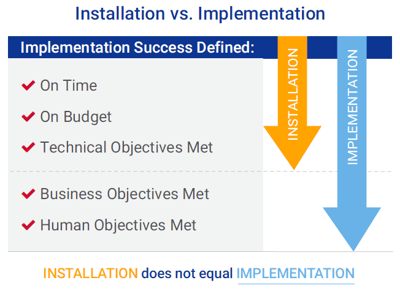Watch This Quick Video Recap:
Many organizations believe they are “special and unique,” but organizations ultimately face very similar challenges when it comes to implementing business or clinical changes. Whether you are implementing new  technology, a Shared Services model or a simple process change, there are certain bumps in the road that need to be avoided.
technology, a Shared Services model or a simple process change, there are certain bumps in the road that need to be avoided.
Here are 5 potential pitfalls you may face on your project, with a few tips and tactics from the AIM Change Management Methodology on what to do about them:
#1 Lack of Clear Scope/Definition from the Starting Gate
One of the most common barriers to any change is the lack of agreement on the scope of the change. Too often there is no clear, concise picture of what the future looks like, or the resources you will need. In the words of Don Harrison, developer of the AIM Change Management Methodology, "If you don't know where you are going, how will you know what it will take to get you there?"
The starting point for every change management project must be a clear, compelling Definition of the Change. This requires the answers to four questions:
- What is changing?
- Why is it changing?
- What are the consequences for not changing?
- And how will success be measured?
We typically find the project team has set clear objectives for timeline, budget and the technical objectives. The missing elements that lead to potential project sub optimization are the lack of a commonly held definition of the business objectives and the human objectives. These human objectives are the behaviors you need to see in the future if the change is implemented successfully.
#2 No Sustained Leadership Support
Sponsorship is the single most important factor in implementation success at speed. Any manager who has direct reports affected by the change is, by definition, a Sponsor. But remember, Sponsorship is both position and action.
All middle and upper level managers must demonstrate their public and private personal commitment throughout the life cycle of the project. There must be alignment between what a Sponsor Expresses, Models and Reinforces with their direct reports. This cascade of committed Sponsors, down and across the organization, is crucial for maximum acceleration.
#3 Declaring Success Too Early, Before Sustained Behavior Change Has Taken Place
There are 5 metrics that must be met on every project to deem it “successful:”
- It’s delivered on time
- It’s delivered on budget
- The technical objectives are achieved
- The business objectives are achieved
- AND it meets the human objectives that have been established for the change
Unfortunately, organizations often make the mistake of measuring success at project “go live.” The technology works; the new processes are introduced; the new job requirements are announced. “It runs, it hums, so we are done!”
This is successful installation. We find most organizations are very good at installing all kinds of changes. But when you measure success at the point of installation, it’s just change at the surface level; you are not getting sustained behavior change, and therefore, value realization for the investment made.
#4 Mistaking a Communication Plan for an Implementation Plan
One of the most common pitfalls we see in our change management consulting work is an organization that mistakes a communication plan for an implementation plan. People still believe if they put together an email strategy, create a website and post a few social media messages, there will be unanimous buy in and magically everyone will change their behavior. But if you could change behavior simply by communication, people wouldn't smoke and everyone would be at their ideal weight.
Yes, communication is important, but it is not enough. A true implementation plan will also include plans for the other elements of change management including (but not limited to) Target Readiness, Sponsorship and Reinforcement.
#5 Agents and Sponsors are Focused on Actions That are “Safe,” but Have Low Impact
Simply put, your Change Agents and Sponsors can be very busy, but are they busy doing the right things? With the rate of change at an all time high, organizations simply cannot afford to have their resources spend time on things that are not delivering value. Many change management methodologies are “activity” based. They focus on a lock step protocol where a Change Agent goes through a set of forms and checklists “to do” change management. But activity and impact are not the same. Instead, Change Agents and Sponsors should be led by core principles that give guidance based on the day to day realities of a project.
How to Avoid Falling into These Pitfalls
To avoid these pitfalls, and many others, organizations need to employ a structured approach to implementation, with skilled Sponsors and Change Agents who have explicit accountabilities, rewards and consequences for the implementation of change projects. Organizations need implementation capability, not just installation capability, if the organization is going to achieve full Return on Investment.
IMA’s proprietary Accelerating Implementation Methodology (AIM) provides systemic, systematic principles, strategies and tactics that can be the central cog of every project, regardless of your project management protocols. It serves as a robust planning and execution tool for the people side of any implementation. Using the AIM Change Management model helps you avoid these potential pitfalls, steering you in the right direction toward value realization for your all your initiatives.


